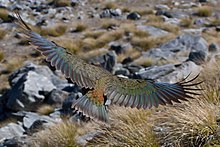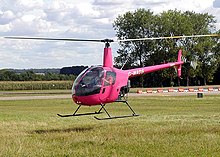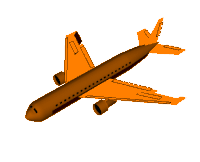Flight is the process by which an object moves either through an atmosphere (especially the air), or movement beyond (as in the case of spaceflight), by generating lift, propulsive thrust or aerostatically using buoyancy, or by simple ballistic movement.
Types
Buoyant flight
Humans have managed to construct lighter than air vehicles that fly due to their buoyancy in air.
An aerostat is a system that remains aloft primarily through the use of buoyancy to give an aircraft that has the same overall density as air. Aerostats include free balloons, airships, and moored balloons. An aerostat's main structural component is its envelope, a lightweight skin containing a lifting gas to provide buoyancy, to which other components are attached.
Aerostats are so named because they use "aerostatic" lift which is a buoyant force that does not require movement through the surrounding air mass. This contrasts with aerodynes that primarily use aerodynamic lift which requires the movement of at least some part of the aircraft through the surrounding air mass.
Aerodynamic flight
Gliding versus powered flight
Some things that fly do not propel themselves forwards through the air. for example, the flying squirrel. This is termed gliding. Others have a source of propulsion and can climb. This is termed powered flight.
Animal
The most successful groups of living things that fly are insects, birds, and bats. The extinct Pterosaurs, an order of reptiles contemporaneous with the dinosaurs, were also very successful flying animals. Each of these groups' wings evolved independently. The wings of the flying vertebrate groups are all based on the forelimbs, but differ significantly in structure; those of insects are hypothesized to be highly-modified versions of structures that form gills in most other groups of arthropods.
Bats are the only mammals capable of sustaining level flight. However, there are several gliding mammals which are able to glide from tree to tree using fleshy membranes between their limbs; some can travel hundreds of meters in this way with very little loss in height. Flying frogs use greatly enlarged webbed feet for a similar purpose, and there are flying lizards which fold out their mobile ribs into a pair of flat gliding surfaces. "Flying" snakes also use mobile ribs to flatten their body into an aerodynamic shape, with a back and forth motion much the same as they use on the ground.
Flying fish can glide using enlarged wing-like fins, and have been observed soaring for hundreds of meters. It is thought that this ability was chosen by natural selection because it was an effective means of escape from underwater predators. The longest recorded flight of a flying fish was 45 seconds.
Most birds fly, with some exceptions. The largest birds, the Ostrich and the Emu, are earthbound, as were the now-extinct Dodos and the Phorusrhacids, which were the dominant predators of South America in the Cenozoic era. The non-flying penguins have wings adapted for use under water and use the same wing movements for swimming that most other birds use for flight. Most small flightless birds are native to small islands, and lead a lifestyle where flight would confer little advantage.
Among living animals that fly, the Wandering Albatross has the greatest wingspan, up to 3.5 meters (11.5 ft); the Great Bustard has the greatest weight, topping at 21 kilograms (46 pounds). Many species of insects also fly .
Mechanical
Mechanical flight is the use of a machine to fly. These machines include airplanes, gliders, helicopters, autogyros, airships, balloons, ornithopters and spacecraft. Gliders are capable of unpowered flight. Another form of mechanical flight is parasailing where a parachute-like object is pulled by a boat. In an airplane, lift is created by the wings; the shape of the wings of the airplane are designed specially for the type of flight desired. There are different types of wings: tempered, semi-tempered, sweptback, rectangular and elliptical. An aircraft wing is sometimes called an airfoil, which is a device that creates lift when air flows across it.
Supersonic
Supersonic flight is flight faster than the speed of sound. Supersonic flight is associated with the formation of shock waves that form a sonic boom that can be heard from the ground, and is frequently startling. This shockwave takes quite a lot of energy to create and this makes supersonic flight generally less efficient than subsonic flight at about 85% of the speed of sound.
Hypersonic
Hypersonic flight is very high speed flight where the heat generated by the compression of the air due to the motion through the air causes chemical changes to the air. Hypersonic flight is achieved by reentering spacecraft such as the Space Shuttle and Soyuz.

The International Space Station in earth orbit
Ballistic
Some things generate little or no lift and move only or mostly under the action of momentum, gravity, air drag and in some cases thrust. This is termed ballistic flight. Examples include ballistic missiles, balls, arrows, orbital spaceflight etc.
Spaceflight
Essentially an extreme form of ballistic flight, spaceflight is the use of space technology to achieve the flight of spacecraft into and through outer space.
Spaceflight is used in space exploration, and also in commercial activities like space tourism and satellite telecommunications. Additional non-commercial uses of spaceflight include space observatories, reconnaissance satellites and other earth observation satellites.
A spaceflight typically begins with a rocket launch, which provides the initial thrust to overcome the force of gravity and propels the spacecraft from the surface of the Earth. Once in space, the motion of a spacecraft—both when unpropelled and when under propulsion—is covered by the area of study called astrodynamics. Some spacecraft remain in space indefinitely, some disintegrate during atmospheric reentry, and others reach a planetary or lunar surface for landing or impact.
History
Leonardo da Vinci is one of the best-known early students of flight. He did many drawings of parachutes wings and ornithopters.
Otto Lillienthal made over 200 gliding flights and was one of the first to understand flight scientifically. His work was replicated and extended by the Wright brothers who made gliding flights and finally the first controlled and extended, manned powered flights.
Physics
There are different approaches to flight. If an object has a lower density than air, then it is buoyant and is able to float in the air without using energy. A heavier than air craft, known as an aerodyne, includes flighted animals and insects, fixed-wing aircraft and rotorcraft. Because the craft is heavier than air, it must use the force of lift to overcome its weight. The wind resistance caused by the craft moving through the air is called drag and is overcome by propulsive thrust except in the case of gliding.
Some vehicles also use thrust for flight, for example rockets and Harrier Jump Jets.
Relevant forces
- Propulsive thrust: (except in gliders)
- Lift: created by the reaction to an airflow
- Drag: created by aerodynamic friction
- Weight: (created by gravity)
- Buoyancy: for lighter than air flight
These forces must be balanced for stable flight to occur.
Flight dynamics

The upward tilt of the wings and tailplane of an aircraft, as seen on this Boeing 737, is called dihedral angle
Flight dynamics is the science of air and space vehicle orientation and control in three dimensions. The three critical flight dynamics parameters are the angles of rotation in three dimensions about the vehicle's center of mass, known as pitch, roll and yaw (See Tait-Bryan rotations for an explanation).
The control of these dimensions can involve a horizontal stabilizer (i.e. 'a tail'), ailerons and other movable aerodynamic devices which control angular stability i.e. flight attitude (which in turn affects altitude, heading). Wings are often angled slightly upwards- they have positive dihedral angle which gives inherent roll stabilisation.
Lift
In the context of an air flow relative to a flying body, the lift force is the component of the aerodynamic force that is perpendicular to the flow direction. It contrasts with the drag force, which is the parallel component of the aerodynamic force. In all cases, aerodynamic lift is associated with pressures on the wing that sum over the area of the flight surfaces to create the lift force, and there is a net movement of air in the opposite direction from the force which is indirectly created by these pressures, in accordance with Newton's third law of motion.
Lift is commonly associated with the wing of an aircraft, although lift is also generated by rotors on rotorcraft. While common meanings of the word "lift" suggest that lift opposes gravity, aerodynamic lift can be in any direction. When an aircraft is in cruise for example, lift does oppose gravity, but occurs at an angle when climbing, descending or banking.
Lift can also occur in a different way if the air is not still, especially if there is an updraft due to heat ("thermals") or wind blowing along sloping terrain or other meteorological conditions. This form of lift permits soaring and is particularly important for gliding. It is used by birds and gliders to stay in the air for long periods with little effort.
Drag
For a solid object moving through a fluid, the drag is the component of the net aerodynamic or hydrodynamic force acting opposite to the direction of the movement. The component perpendicular to this direction is considered lift. Therefore drag opposes the motion of the object, and in a powered vehicle it is overcome by thrust.
Lift-to-drag ratio
When lift is created by the motion of an object through the air, this deflects the air, and this is the source of lift. For sustained level flight lift must be equal to weight.
However, this lift inevitably causes some drag also, and it turns out that the efficiency of lift creation can be associated with a lift-to-drag ratio for a vehicle; the lift-to-drag ratios are approximately constant over a wide range of speeds.
Lift-to-drag ratios for practical aircraft vary from about 4:1 up to 60:1 or more. The lower ratios are generally for vehicles and birds with relatively short wings, and the higher ratios are for vehicles with very long wings, such as gliders. In general, long wings permit a large amount of air to be deflected and accelerated by a small amount, rather than a small amount of air by a large amount. Since energy is a square law on speed, whereas lift is a linear relation, it takes less energy, and less drag is created, with large wings.
Thrust to weight ratio
Thrust-to-weight ratio is, as its name suggests, the ratio of instantaneous thrust to weight (where weight means weight at the Earth’s standard acceleration g0). It is a dimensionless parameter characteristic of rockets and other jet engines and of vehicles propelled by such engines (typically space launch vehicles and jet aircraft).
If the thrust-to-weight ratio is greater than the local gravity strength (expressed in gs), then flight can occur without any forward motion or any aerodynamic lift being required.
If the thrust-to-weight ratio times the lift-to-drag ratio is greater than local gravity then takeoff using aerodynamic lift is possible.
Energy efficiency
To create thrust so as to be able to gain height, and to push through the air to overcome the drag associated with lift all takes energy. Different objects and creatures capable of flight vary in the efficiency of their muscles, motors and how well this translates into forward thrust.
Propulsive efficiency determines how much energy vehicles gain from a unit of fuel.
Range
The range that powered flight articles can achieve is ultimately limited by their drag, as well as how much energy they can store on-board.
For powered aircraft the useful energy is determined by their fuel fraction- what percentage of the take-off weight is fuel, as well as the specific energy of the fuel used.
Power to weight ratio
All animals and devices capable of sustained flight need relatively high power to weight ratios to be able to generate enough lift and/or thrust to achieve take off.
Guidance
A guidance system is a device or group of devices used to navigate a ship, aircraft, missile, rocket, satellite, or other craft. Typically, this refers to a system that navigates without direct or continuous human control. Systems that are intended to have a high degree of human interaction are usually referred to as a navigation system.
In aircraft, successful air navigation involves piloting an aircraft from place to place without getting lost, breaking the laws applying to aircraft, or endangering the safety of those on board or on the ground.
The techniques used for navigation in the air will depend on whether the aircraft is flying under the visual flight rules (VFR) or the instrument flight rules (IFR). In the latter case, the pilot will navigate exclusively using instruments and radio navigation aids such as beacons, or as directed under radar control by air traffic control. In the VFR case, a pilot will largely navigate using dead reckoning combined with visual observations (known as pilotage), with reference to appropriate maps. This may be supplemented using radio navigation aids.
Control
Flight
A conventional fixed-wing aircraft flight control system consists of flight control surfaces, the respective cockpit controls, connecting linkages, and the necessary operating mechanisms to control an aircraft's direction in flight. Aircraft engine controls are also considered as flight controls as they change speed.
Traffic
In the case of aircraft, air traffic is controlled by air traffic control systems.
Collision avoidance is the process of controlling spacecraft to try to prevent collisions.
Flight safety
Air safety is a term encompassing the theory, investigation and categorization of flight failures, and the prevention of such failures through regulation, education and training. It can also be applied in the context of campaigns that inform the public as to the safety of air travel.











No comments:
Post a Comment